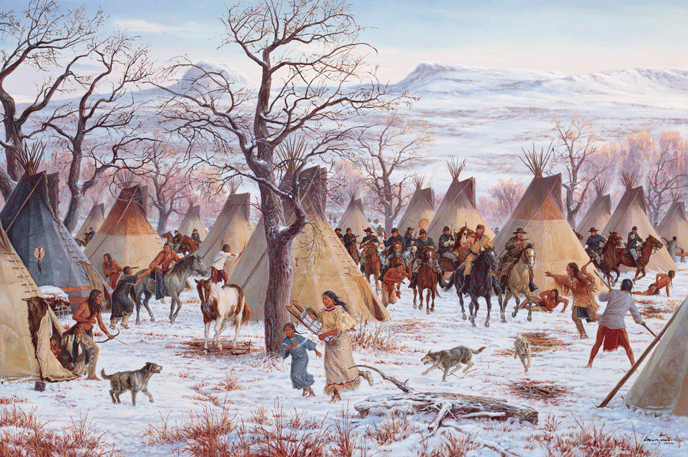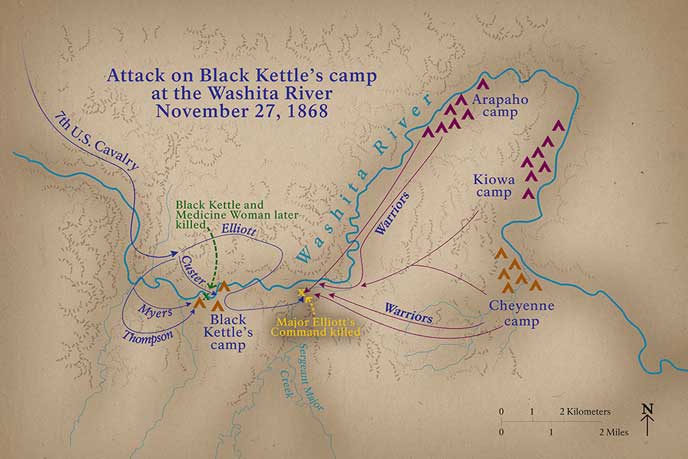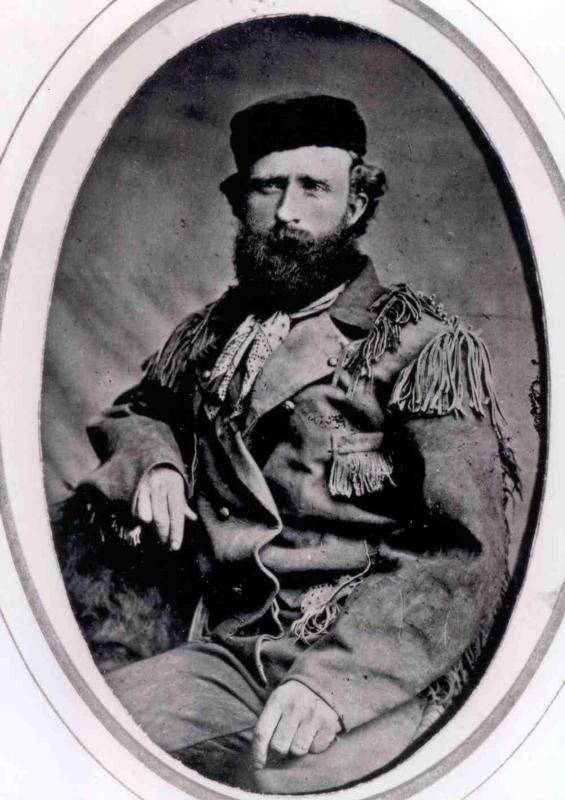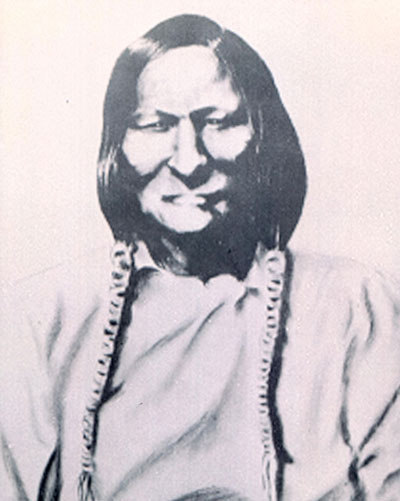As with the post on the Sand Creek Massacre, this history contains
accounts of graphic violence. Do not read any further if this will upset you.
 |
| The 7th Cavalry attacking Black Kettle's camp on the Washita River (From the exhibit at the Washita Battlefield NHS) |
On November 26, 1868, the Peace Chief Black Kettle had just
returned to his Washita River camp from a strenuous 100 mile mission through
the snow to request permission to move his camp closer to Arapaho, Kiowa, and other
Cheyenne tribes downriver. Permission was denied. His wife, Medicine Woman
Later, uneasy with the rumors of U.S. troops in the area, wanted to move that
night. She had good reason to feel uneasy. In 1864, at Sand Creek in Colorado,
U.S. troops had attacked their peaceful camp, killed 125, and shot her nine
times. She survived, but now at their winter camp, she had a premonition. The
council of elders decided to wait until the next morning to move.
 |
| Map of Battle (From Washita Battlefield NHS web site) |
 |
| Looking at the hills to the northwest over which Custer and his troops rode to attack the camp among the trees in the middle of the picture (Photo by Hunner) |
 |
| Some Cheyenne hid in the tall grass to escape the soldiers (Photo by Hunner) |
 |
| Place where horses and mules were slaughtered (Photo by Hunner) |
With ammunition running low and a growing force of enraged
warriors nearby, Custer feinted a move to go downriver which sent the warriors
retreating to protect their own camps. Relieved of a possible counterattack,
the 7th Cavalry and their prisoners stole away into the fading
light.
This is the second act in the tragedy of the southern plains
Indian War. As Ranger Joel Shockley recounted, the first act happened at Sand Creek. When Col. Chivington and his soldiers attacked Black Kettle’s camp of
peaceful Cheyenne and Arapaho in 1864 at Sand Creek, a Plains War erupted that
lasted for years, culminating in the Battle at Little Big Horn (Joel’s third
act). In response of the Sand Creek Massacre, warriors from the Cheyenne Dog Soldiers
rampaged across the southern Plains to avenge their fallen comrades and family
members. Peace treaties came and went, and Black Kettle signed some of them,
but he had little control over the attacks by the warriors.
Francis Gibson, a lieutenant in the 7th Cavalry,
later estimated that between August and November in 1868, 117 people were
killed in the southern plains by the Dog Soldiers, with others scalped or captured,
and almost 1,000 horses and mules stolen. As Western historian Paul Hutton said
in the movie at the Washita visitors’ center: “The Army was humiliated. This
was the Army that had defeated Robert E. Lee.” Something had to be done.
The Commander in charge of the Department of the Missouri,
Major General Philip Sheridan, called for total war against the Indians. His
aide-de-camp, Schuyler Crosby wrote: “The General’s policy is to attack and
kill all Indians wherever met and to carry war into their own villages so that
they will have to withdraw their marauding bands for the protection of their
own families.”[1]
 |
| Lt. Col George Custer as he looked during the winter campaign at Washita (https://www.nps.gov/common/uploads/photogallery/imr/park/waba/) |
As I left the film about the massacre, I noticed that the
other guy in the room had a t-shirt from Fort Pulaski. I struck up a
conversation with Tim Sprano from Lynchburg, Virginia. He is a veteran park
goer, having visited 371 of the 412 in the system over the last fifteen years.
He teaches mathematics at Liberty University, but his other passion is our
national parks. He remarked that every park has its own reason to exist, so
take what it gives you. Here at Washita, he commented: “Obviously, we wouldn’t
do stuff now that they did 100 years ago. We have different values today than
of the past so it’s important to see and hear the whole story.”
After the movie, Park Rangers Joel Shockley and Richard Zahm
spent over an hour chatting with me about what happened at Washita. Richard
said this was an important site because people truly learn about our past
here-- people who just stop by to stamp their NPS passports end up staying here
all day. He said: “It’s so much more complicated than just cowboys and
Indians…. I thought when I came out here, it would be a lot of black and white
and it’s not. There are good guys and bad guys on all sides.”
Joel agreed: “This is one of the best kept secrets in
American history. It is far more complicated. This was like the Oklahoma City
bombing for the tribes or like 9/11. There were not just Cheyenne here, there
were a lot of Indians involved, and Mexicans too. Half of Custer’s command were
immigrants from Ireland and Germany, a way to become citizens. All these
cultures came together by happenstance…. This is part of your heritage, whether
you have Indian in you, have soldier in you. It’s part of our heritage – all
our warts and blemishes.”
[3] After the Civil War, the Army used the tactics and weapons to wage total war to force Indians to move to reservations and kill those who refused to go. This last chapter of the Indian Wars in North America played out over the decade or so right after the Civil War. The legacy of conquest lives with us today, and as Richard, Joel, and Tim note, it is a complicated story viewed from our 21st century eyes.
 |
| NPS Ranger Richard Zahm (Photo by Hunner) |
[3] After the Civil War, the Army used the tactics and weapons to wage total war to force Indians to move to reservations and kill those who refused to go. This last chapter of the Indian Wars in North America played out over the decade or so right after the Civil War. The legacy of conquest lives with us today, and as Richard, Joel, and Tim note, it is a complicated story viewed from our 21st century eyes.
Everywhere I have traveled in Driven by History, I have run
into the deep heritage of our land, which starts with Native American peoples.
They had rich and complex civilizations before Europeans arrived, they lost
much of their ancestral lands and their culture, and they are still here.
The Washita Battlefield became an Oklahoman state park in
October 1966 and a National Historic Site on November 12, 1996.


Being a historian of the American West, what happened to the Native American people is a tragic and largely forgotten part of our history. Thankfully the park service is helping to keep it alive
ReplyDelete